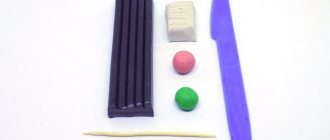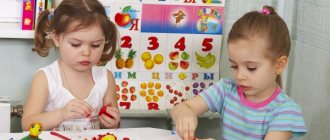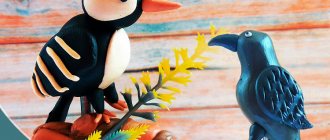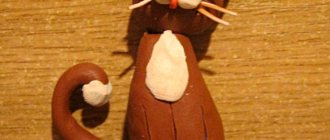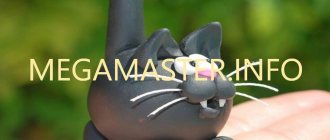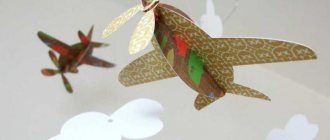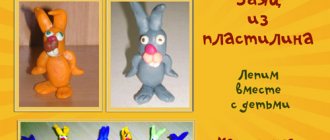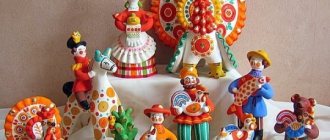Sculpting cats and kittens is always interesting; these cute pets are well known to every child, so he can calmly create without being distracted by trying to find out how the animal looks or moves. At the same time, you can create not only realistic figures, but also characters from your favorite games, fairy tales or cartoons. A cat made of plasticine will be a good gift for a mother, grandmother or teacher to make the craft look prettier; it can be easily supplemented with beads, rhinestones or other decorations.
- Basics of working with plasticine: how to get started
- Step-by-step instructions with photos on how to make a sitting cat from plasticine
- Video master classes on how to sculpt a sitting cat
- Modeling kittens from plasticine is easy: instructions for children and toddlers
- Black kitten made of plasticine
- Cute pink baby
- Craft for the little ones
- Reclining figurine
- Adorable kitty
- A simple figurine made from one piece
- Mobile craft
- Egg figurine from Kinder Surprise
- Black catfey
- Examples of ready-made crafts
- Video lessons for children on sculpting cats and kittens
- Cat and cute kittens from plasticine: making a family
- Other examples of sculpting cat families
- Detailed and intricate animal figures
- Video tutorial on sculpting beautiful and realistic figures from plasticine
Basics of working with plasticine: how to get started
Before making a cat out of plasticine, you should prepare the material of the desired color; if such a block is not in the box, you can mix several different pieces.
The most convenient way to start sculpting any parts is by rolling balls, which are subsequently given the desired shape. To draw fingers or fur on a plasticine craft, it is better to prepare toothpicks in advance - the stack may be too thick for neat lines (it is also convenient to attach the figure’s head to them so that it holds more securely). Antennae can be easily made from pieces of wire or pine needles, and beads can be installed instead of eyes.
If you mix pieces of different colors (for example, orange, black and white), not completely, you will get the original three-color color of the animal.
Summary of a modeling lesson in the preparatory group “Child with a kitten”
Lyudmila Kovalevskaya
Summary of a modeling lesson in the preparatory group “Child with a kitten”
Summary of the modeling lesson “ Child with a kitten ”
Teacher Kovalevskaya L.N.
Topic: Child with a kitten . Preparatory group .
Goal: To teach children to depict a simple scene in modeling , showing the movement of human and animal figures.
— consolidate the ability to sculpt a human figure in motion.
— Strengthen the ability to sculpt an animal figurine in parts.
- consolidate the ability to use techniques: pinching, pulling, rolling, rolling, joining.
Materials: boards, napkins, plasticine, illustration “ Child with a kitten ”
,stack.
Step-by-step instructions with photos on how to make a sitting cat from plasticine
A cute sitting cat that will be interesting to sculpt for children in the older group or even younger.
How to make a plasticine cat for children with your own hands step by step:
- Roll and flatten the ball a little - the head and shape the muzzle.
- Make two triangles - ears.
- Add wire whiskers.
- Form a large cone for the body.
- Roll two balls for the front paws and two drops for the back paws.
- Assemble the body and draw the legs and claws.
The animal's paws are outlined with three rather than two lines.
Video master classes on how to sculpt a sitting cat
"These funny cats." Thematic notes for older age. Modeling lesson “Cats-artists”
Elena Meleshko
“These funny cats.”
Thematic notes for older age. Sculpting lesson “Cats-Artists” Sculpting lesson in the senior group “
Cats-Artists ” .
Goal: To teach children to create an animal image in modeling . Strengthen the ability to sculpt from a whole piece using clay cuts from the ends. Use different techniques in work: rolling clay between the palms, pulling small parts, connecting parts by pressing and smoothing the joints. Learn to convey the pose of a cat in sculpting .
Preliminary work: Conversation about pets. Examination of illustrations in books, albums (image of animals by Yu. Vasnetsov,
E. Charushin). Reading of the poem by V. Shipunova “What the Siberian cat dreams of”
. Visit with parents to the Yu. Kuklachev Cat Theater. Looking at a toy cat.
Material: Clay, board, stack, cloth napkin (wet)
for each child, a
cat .
Cat and cute kittens from plasticine: making a family
How to make a cat with kittens from plasticine:
- Cut a long sausage at both ends to highlight the legs.
- Bend the workpiece into the shape of the body.
- Attach the ponytail.
- Roll out a ball-head, use your fingers to separate triangles-ears from it and slightly extend the nose part.
- Decorate the muzzle with voluminous details or paints and add a mustache.
- Form small kittens from plump sausages, outlining the neck line and extending long tails.
For kids in the older group, for whom it is easy to sculpt such a figurine, it is worth offering to invent and make an older cat and kitten.
Other examples of sculpting cat families
To make plasticine kittens and cat figures more accurate, the surface of the parts is smoothed with wet fingers.
Notes on sculpting "Kitten" lesson plan (senior group)
SUMMARY OF NODS
on productive activities (modeling) for children of the older group
Theme: "Kitten"
Tasks:
Educational:
Create an image of an animal in sculpting; convey the pose of a kitten in sculpting.
Strengthen the ability to sculpt an animal figurine in parts, using different techniques: rolling clay between the palms, pulling out small parts, connecting parts by pressing and smoothing the joints.
Educational:
Develop fine motor skills of children's hands.
Educational:
Cultivate a love for pets.
Integration of OO: artistic and aesthetic development, cognitive.
Progress of the lesson: Children sit on chairs placed in a semicircle. The teacher comes in with a basket. Guys, today one pet came to visit us. But it is very sad, because he has no friends. And in order to find out who is sitting there, we need to solve several riddles.
What kind of animal is playing with me? Doesn't moo, doesn't neigh, doesn't bark, attacks balls, hides claws in its paws.
Mustachioed muzzle Striped fur coat Washes often But doesn’t know how to handle water.
He cries at the threshold, hides his claws, quietly enters the room, purrs and sings. That's right, guys - it's a kitten.
Do you agree to help him (children's answers). Let us make friends for our kitten from plasticine. And in order to make friends for him, we must pass several tests. 1. Does anyone know a poem about a cat? (reading a poem by Natalya). 2.The second task is called “What’s missing?” (finish the kitten) 3. Third task - “Fold a kitten from geometric shapes” (children take turns folding a kitten from geometric shapes).
Physical education minute:
The window opened (arms to the sides) The cat came out onto the ledge (cat’s smooth gait)
The cat looked up (the head was thrown up)
The cat looked down
I looked to the left
I watched the flies
Stretched and smiled
And she sat down on the ledge.
So we got to our modeling table. We have already sculpted a horse. Let's remember where to start sculpting (knead the plasticine and divide it into parts). What shape is a kitten's body? Head? Tail? (oval, elongated head, long tail). We will sculpt from a whole piece of plasticine. Tamara, tell us how we will sculpt (we need to roll out a thick sausage, cut it into a stack on both sides - these are the legs. Then we roll out the ball - stretch out the muzzle and ears. We attach the muzzle to the body and smear it well. The tail should be thin and long). Guys, to warm up our hands before work, we will do some finger exercises.
Cunning, little Kitten (ball squeezed between palms) Just got out of diapers, (palms open) Did a lot of things: (palms close) Ate a fish from a raccoon, (circular movements between palms) Started a fight with a hamster, (Squeeze the ball in your right hand) Only the dog was scared. (squeeze in left hand) Ill-mannered child (circular movements on the table with one hand) This little Kitten. (circular movements on the table with the other hand) Let's start sculpting. Children sculpt, the teacher helps individually as needed. Well done guys, you all coped with the task. Now our cat is very happy, and thanks you all for new friends.
Detailed and intricate animal figures
Progress of the lesson:
Guys, you recently visited Yuri Kuklachev’s Cat Theater. Did you like performing cats ?
Children talk about their impressions.
— Do you want to make a cat and organize your own Cat Theater in our group?
- Then let's look at it. What shape is a cat's ?
- What kind of head does our cat ?
- What’s on the cat’s head ?
— Does our cat have a tail ? What is he like?
Long, oval, fluffy.
- How can you blind a cat ?
From pieces: from a ball - a head, from a cylinder - a torso, from small cylinders - legs and a tail.
- I’ll remind you of another sculpting that will help us sculpt cats and show how they move.
Divide the lump of clay in half - cut off in a stack; one half - for the body and paws; the other is for the head and tail. We make a cylinder from one part. Animals usually move on four legs, so the cylinder (roller)
you need to turn it like this
(the teacher turns the cylinder into a horizontal position)
. Then bend it in an arc and cut it at both ends with a stack to make four legs. This is a body with legs. All that remains is to sculpt the head and tail. Tell me how best to do this?
— You and I sculpt not just cats, but cats who are artists. Therefore, the body can be positioned as if the animal is standing on two legs, or on four. And the head can be attached to the body from above or to the side, on the neck or directly on the body.
— There are many artists in the Cat Theater. May you get different cats !
Children begin sculpting , independently choosing a pose for the sculpted cat .
At the end of the work, the teacher says:
- You made a cat , now let's see what your cat , what number it is showing us.
The teacher examines all the sculpted figures and notes the most expressive ones.
- Now let’s choose a place in the group for our Cat Theater so that it’s convenient to organize performances!
Ginger cat
The sign says that a ginger cat brings good luck to the owner.
To make a figure from plasticine, prepare a place and the necessary tools:
- orange plasticine;
- additional colors - yellow, green - for eyes, brown, white or any other colors - for decorations;
- match;
- stack - a plastic knife for work.
Modeling a cat from plasticine consists of the following steps:
- Take a brick of orange material for the body. You will need 3 times less white plasticine; parts are made from it.
- Roll an oval out of the red-colored mass and pull the workpiece out on one side. You will get a long neck. We insert a match into it to secure the cat's face. We slightly bend the shape to get a figurine of a sitting animal. We attach a small white spot on the cat’s chest - it will be like a tie for the cat. Using a special knife, we make small grooves that imitate animal fur.
- We form 2 orange tablets for the bent hind legs and secure them on both sides of the body. At the bottom we attach small white plasticine pads.
- We twist 2 orange tubes for the cat's front legs. We expand them at the ends.
- We make the head in the shape of a flattened diamond. We make triangular ears from 2 miniature orange tablets.
- We attach the front legs to the cat's body. They should be about the same level. We make a tail and attach it to the body. We glue a white plasticine mustache, cheeks and a pink nose to the head.
- We attach the ears to the head. We cut strips on the mustache with a stack. To get slanted cat eyes, we stick green pupils to oval shapes made of white material. We fix the eyes on the muzzle.
- We connect the head to the body with a match.
More interesting: Step-by-step master classes and instructions on how to sculpt animals from plasticine
